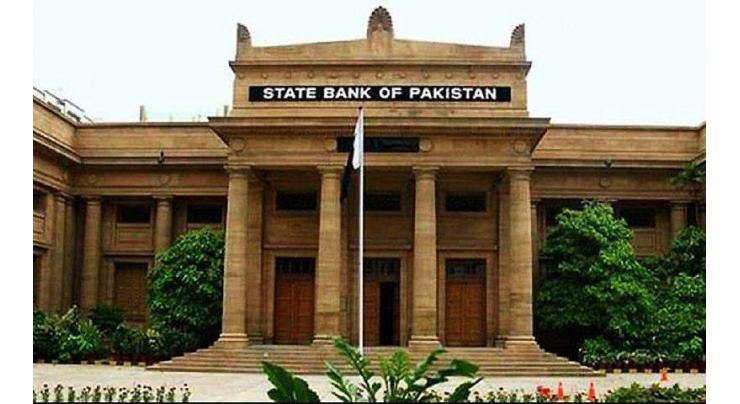
The State Bank Of Pakistan (SBP) Releases Half Yearly Report On Country's Economy
Muhammad Irfan Published May 19, 2023 | 09:52 PM

The State Bank of Pakistan (SBP) on Friday released its half yearly report on the country's state of economy, encompassing economic performance and challenges faced on both internal and external sectors
KARACHI, (UrduPoint / Pakistan Point News - 19th May, 2023 ):The State Bank of Pakistan (SBP) on Friday released its half yearly report on the country's state of economy, encompassing economic performance and challenges faced on both internal and external sectors.
The analysis in the report based on data out-turns for July-December 2022-23 indicated that Pakistan's macroeconomic conditions weakened during H1-FY23 despite policy induced improvement in external current account and primary fiscal balance, an SBP news release said.
The report noted that adverse global economic conditions, uncertainty surrounding the completion of IMF (International Monetary Fund) programme's 9th review, insufficient external financing and low level of foreign exchange reserves remained major concerns during H1-FY23 which were exacerbated by the fallout of flash floods and political instability.
"Specifically, both agriculture production and large scale manufacturing (LSM) contracted; whereas, headline inflation rose to multi-decade high level," it added.
To address the challenges, the SBP raised the policy rate by a further 225 bps in the first half of FY23, on top of the 675 bps increase during FY22 while the government resorted to curtail federal expenditures on grants, subsidies and development, the report mentioned.
For containing pressures on external account the government and the SBP also introduced various regulatory measures to restrict imports.
Despite visible contraction in domestic demand inflation out-turns remained stubbornly persistent since second half of FY22 as high global commodity prices along with elevated inflation expectations and a range of domestic factors pushed the national consumer price index (NCPI) inflation to 25.0 percent during H1-FY23 in comparison to 9.8 percent in the corresponding period last year, the report stated.
Higher food prices, on account of flood induced supply shortages, mainly drove overall inflation followed by non-food and non-energy (NFNE) and energy groups while Pak Rupee depreciation along with the increase in power tariffs and energy prices provided further impetus to inflationary pressures, the SBP noted, adding the second round effect of those supply shocks to broader prices and wages along with rising inflation expectations pushed up core inflation.
Covering the fiscal sector, the report highlighted the contraction in major non-interest current expenditure, particularly subsidies, grants, and development spending, which contributed to improvement in primary surplus during H1-FY23.
However, it observed, that the fiscal deficit remained at the last year's level, in terms of GDP (gross domestic product), because of a sharp expansion in interest payments.
On the revenues side, tax administration efforts, inflation and higher return on deposits led to an expansion in FBR (Federal Board of Revenue) taxes, however a sharp contraction in imports and an overall dip in economic activity constrained tax collection below the target for the first half of FY23.
The SBP indicated that in the absence of sufficient external inflows, the government mainly relied on domestic bank and non-bank sources to meet its borrowing requirements, mostly through medium term floating rate instruments.
The private sector credit (PSC) decelerated during H1-FY23 amid economic slowdown and growth in working capital loans within PSC weakened while fixed investment remained around the last year's level.
Uncertainty regarding the resumption of IMF programme, along with tight global financial conditions affected the external sector, in general, and external financing, in particular, during the period under review.
Meanwhile, supply chain disruptions resulting from Russia-Ukraine conflict and China's zero - Covid policy, hampered global demand, which also weighed on Pakistan's export performance.
On the supply side, the report identified flood-related disruptions as a cause of lower crop out-turns, which not only dented the food exports but also deteriorated the commodity import outlook.
Though global economic slowdown and increased use of informal channels affected flow of remittances to the country and workers' remittances declined during H1-FY23, the report noted and added that decline in exports and remittances was more than offset by a much larger fall in imports leading to a notable decline in current account deficit (CAD).
Despite the improvement in CAD, the report noted that the dearth of financial inflows led to decline in foreign exchange reserves during H1-FY23.
In addition to the delays in the disbursements of the IMF tranches and the political uncertainty in the country, higher net FX outflows on account of scheduled debt repayments and disinvestments added to external account pressures.
The combined effect of the developments, in the backdrop of US dollar's appreciation against a basket of global currencies, led to PKR depreciation during H1-FY23.
The report also featured a special section on the opportunities and challenges in Pakistan's software-led IT exports and technology start-ups.
While highlighting the country's small share in global IT (information technology) exports and negligible domestic software usage, the report shed light on the enabling policies that had facilitated growth in that space and some of the critical gaps that were to be addressed, if recent growth in the sector was to be sustained.
Related Topics
Recent Stories

Currency Rate In Pakistan - Dollar, Euro, Pound, Riyal Rates On 27 April 2024

Today Gold Rate in Pakistan 27 April 2024

HEC reviews curricula for environmental sciences degree programme

ICC Asia looking forward to an action-packed Asia Cricket Week

Yuvraj Singh named ICC Men’s T20 World Cup 2024 Ambassador

Greece hands Olympic flame to 2024 Paris Games hosts

Two Kyiv hospitals evacuating over feared Russian strikes

World must act on neurotech revolution, say experts

Charles & Catherine's cancer diagnoses

Champions Alcaraz and Sabalenka through in Madrid Open

King Charles to resume some public duties during cancer treatment: palace

US defense chief announces $6 bn in security aid for Ukraine
More Stories From Business
-

Currency Rate In Pakistan - Dollar, Euro, Pound, Riyal Rates On 27 April 2024
21 minutes ago -

Today Gold Rate in Pakistan 27 April 2024
1 hour ago -

Finance minister reviews progress on FBR digitalization
10 hours ago -

US stocks rebound on tech earnings, London hits new record
10 hours ago -

US approves gene therapy treatment for hemophilia
10 hours ago -

KATI president for inclusion of agri sector in tax net
10 hours ago
-

Ahsan chairs 13th CPEC-JCC preparatory meeting, reviews arrangements for high-level delegation’s v ..
12 hours ago -

Police to take every step for security of business community: IGP
12 hours ago -

WB director, Planning minister discuss reforms in development projects
12 hours ago -

IP rights crucial in achieving SDG : Jam Kamal
13 hours ago -

FBR’s data protection efforts commended by OECD assessment team
13 hours ago -

US stocks rebound on tech earnings, London hits new record
14 hours ago

















